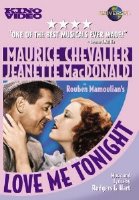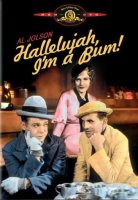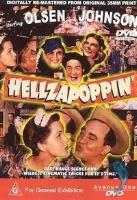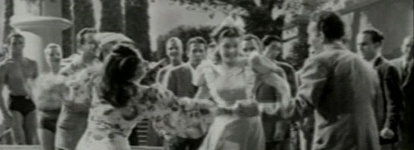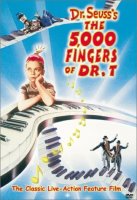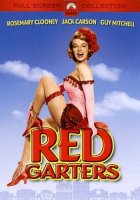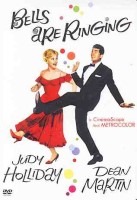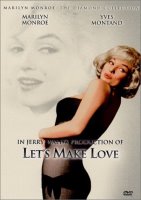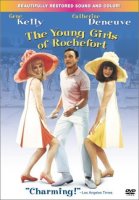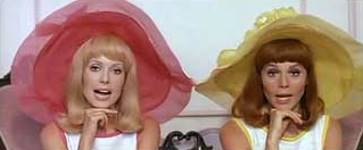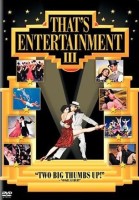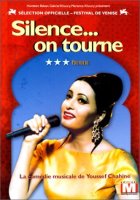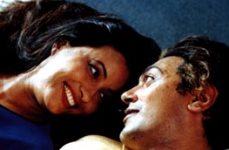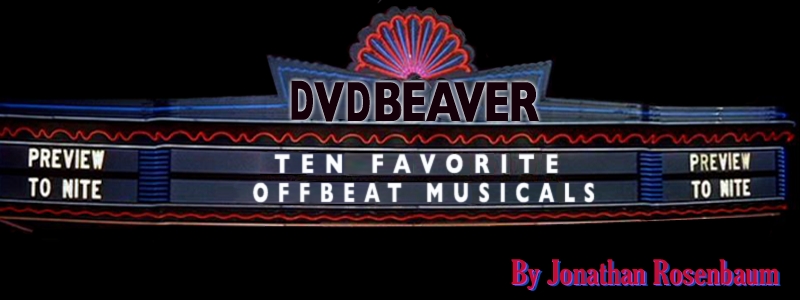 |
||
| Consider the following not so much a definitive list--offerings and preferences keep changing—as a starting point for checking out some of the weirdest and most pleasurable musical comedies in my personal pantheon. The order is chronological. | ||
|
(CLICK COVER FOR MORE) Love Me Tonight (Rouben Mamoulian, 1932) |
A controversy used to rage about whether this was “imitation Lubitsch with too many camera angles” (as Andrew Sarris once put it) or a lighthearted send-up of Ernst Lubitsch (as Tom Milne argued in his book on Mamoulian). Since the movie costars Maurice Chevalier and Jeanette MacDonald, the same leads as Lubitsch’s previous The Love Parade and The Smiling Lieutenant, and Lubitsch himself was production chief at Paramount when it was made, these issues can’t be resolved simply. But my own preference for this masterpiece over the Lubitsch films that influenced it comes easy, and not only because it’s appeared on DVD ahead of them. It has a wonderful Rodgers and Hart score and a singular impulse to encompass nothing less than the entire world in its musical numbers. Towards the beginning, “Isn’t it Romantic?” passes from Chevalier (a tailor in Paris) to a customer to a composer passing on the street to a cab driver to soldiers on a train to a Gypsy fiddler in the countryside to MacDonald singing on a distant balcony; and plenty of non-singers are allowed to take over bits of subsequent songs, like the reprise of “Mimi”. Furthermore, the inventiveness of Mamoulian’s staging, framing, editing, and pacing never quits. | |
|
|
||
|
|
||
| Rodgers and Hart scored this one too, and once again it’s closer to operetta than to the usual song-and-dance stuff. It’s hard to know whether the remarkable inventiveness comes from the story (Ben Hecht), screenplay (S.N. Behrman), preproduction director (Harry d'Abbadie d'Arrast) or final director (Milestone). Who thought up the devastating montage parody of Eisenstein timed to the American anthem, or an illustration of economic deflation via throwaway dialogue during a tracking shot across a bank floor, or the notion of a Trotskyite trash collector played by Harry Langdon? And what about the rhyming dialogue, or the homoerotic relationship between a black and a white tramp? We know that a portion of the parable-like plot involving the mayor of New York (Frank Morgan), his amnesiac mistress (Madge Evans), and the mayor of New York’s homeless (Al Jolson) was lifted from Chaplin’s City Lights, but who put it all together with such bittersweet conviction? This was one of Jolson’s rare commercial flops, but it’s so sad and peculiar that one isn’t surprised. Even though it’s a fantasy, the Depression in all its grief comes alive here as in few other pictures. |
(CLICK COVER FOR MORE) Hallelujah I’m a Bum (Lewis Milestone, 1933) |
|
|
|
||
|
|
||
|
(CLICK COVER FOR MORE) Hellzapoppin’ (H.C. Potter, 1941) |
Because of rights issues regarding the original stage show by Nat Perrin, this wild movie is almost impossible to find in the U.S., though copies turn up regularly on eBay and elsewhere. (My own copy is Australian.) This may be the most deconstructive and self-referential of all Hollywood farces. It’s constantly on the move, and the musical bits--which include fine, jazzy numbers by Martha Raye and the dynamite duo of Slim Galliard and Slam Stewart—-are just about the only parts that seem conventional. Like the zoot suits and the casting of such types as Mischa Auer, Hugh Herbert, Shemp Howard, and Elisha Cook Jr., they certainly date this movie--along with a gag reference to Citizen Kane’s Rosebud sled, veiled illusions to the overseas war, and even the two leads, Ole Olson and Chick Johnson. But as with Halleluiah I’m a Bum, this only makes the movie more precious and time-capsule-worthy. And it’s pretty damned funny, too. | |
|
|
||
|
|
||
| Theodore Geisel--the real name of children’s book author Dr. Seuss—-was so traumatized by what happened to his dream project in terms of changes and various production disasters that he never worked in movies again, preferring TV specials thereafter. But so much of his imagination as well as the zeitgeist of the period leaks through this Freudian Stanley Kramer fantasy that it’s become a treasured cult object; there’s even an elaborate web site devoted to it. A ten-year-old boy (Tommy Rettig) without a visible father, forced to take piano lessons from a prissy European-like tyrant (Hans Conreid), falls asleep and dreams the remainder of the movie, set in the tyrant’s castle, where his hypnotized mother (Mary Healy) is held prisoner and he, along with 499 other little boys, is forced to play Dr. T’s terrible piano exercise on one continuous keyboard. His only ally is a plumber (radio star Peter Lind Hayes; Geisel wrote the part for Karl Malden to play as an old codger). A study in surrealist excess and nightmarish conceits (check out that dungeon of banned musical instruments), it comes to life especially during its chases and its grandiose musical numbers. |
(CLICK COVER FOR MORE) The 5,000 Fingers
of Dr. T |
|
|
|
||
|
|
||
|
(CLICK COVER FOR MORE)
Red Garters |
An opening title already prepares us for something odd and self-conscious: “Many people have said: `The movies should be more like life!’ and a wise man answered, ‘No! Life should be more like the movies!’” So when we subsequently see Guy Mitchell singing, “With a Whoop and a Holler and a Dime and a Dollar,” dressed in white and riding a white horse through the strangest see-through set on a soundstage to be found in any western musical—-somewhere east of Lars von Trier’s Dogville in terms of sheer diagrammatic spareness—-we know we’re never going to see the real sky in this movie, or any tree that isn’t sculpted. Indeed, it’s hard to know where we are, or how such an experimental effort ever emerged from Paramount. But we do know that the great writer-director Frank Tashlin (Artists and Models, The Girl Can’t Help It), who receives no screen credit, spent half a year developing an earlier version of this movie in 1952. The other satirical (and Tashlinesque) musical that Red Garters most resembles, Li’l Abner (also available on DVD), was released by the same studio five years later, brandishing equal amounts of stagey artifice (though in this case adapted from a stage musical), comic-book colors, and broad, raucous characters. Rosemary Clooney and Jack Carson costar. | |
|
|
||
|
|
||
| Film academic Jane Feuer argues that the musical is mainly a conservative capitalist genre where traditional values get reinforced, so part of what’s so refreshing and singular about this winning Judy Holliday vehicle (her final role, adapted from a stage hit) is how socially progressive it is. (By comparison, even The Pajama Game, a pro-union musical, is almost terminally sexist.) This is about a lonely switchboard operator who works for a Manhattan answering service and insists on linking up her company’s various clients with one another, meanwhile helping them to straighten out their lives. The famous team of Betty Comden and Adolph Green (Singin' in the Rain) wrote this, Jule Styne supplied the terrific tunes, and Dean Martin does a fine job with the part of a blocked playwright. As usual, Minnelli knows how to get the most out of CinemaScope framing, taking the story’s utopian notion of social interaction and literally stretching it out visually. Among the period touches are Frank Gorshin’s parody of Marlon Brando’s Method acting; among the cameos are Holliday’s own husband, jazzman Gerry Mulligan, as a blind date; and among the memorable songs are “Just in Time” and “The Party’s Over”. |
(CLICK COVER FOR MORE) Bells Are Ringing (Vincente Minnelli, 1960) |
|
|
|
||
|
|
||
|
(CLICK COVER FOR MORE)
Let’s Make Love |
Part of what’s unusual about this Fox musical in CinemaScope is the delightful and serious way Marilyn Monroe revamps her own persona--moving away from the isolated dumb blond she made famous over the previous decade and embodying for once an intelligent and generous team player, working in a satirical revue being staged in Greenwich Village while dating her costar (English singer Frankie Vaughan). The same revue ridicules a French billionaire playboy (Yves Montand), and Monroe’s character can’t be blamed for not knowing that the actual playboy, motivated mainly by his desire to spend more time with her, has pseudonymously auditioned for that bit part and landed it, while such employees as Tony Randall and Wilfrid Hyde-White—-not to mention Milton Berle, Bing Crosby, and Gene Kelly, all playing themselves--try to help him win her away from Vaughan. The comedy deconstructs both stardom and the attempt to buy everything with money, and even though Montand finally triumphs, it’s Monroe and Vaughan who carry much of the show—-and deliver most of the songs. Jack Cole staged the numbers, keeping such tunes as “My Heart Belongs to Daddy,” “Those Crazy Eyes,” and “Incurably Romantic” agreeably small-scale and life-size. | |
|
|
||
|
|
||
| Maybe it sounds crazy to select this jubilant yet tragic French tribute to both France and the Hollywood musical as my favorite example of the genre, but there it is. English and French versions of this superproduction were shot, but the former is a collector’s item that rarely got shown and the latter is better on all counts. The score is Michel Legrand's finest, with well-integrated jazz elements, lyrics in alexandrines by Demy, and intricately structured reprises that match the poetic, crisscrossing plot about various dreamers searching for and usually missing their ideal mates, who are usually only blocks away. It’s the only movie pairing Catherine Deneuve and her late sister Françoise Dorléac, and the fact that they actually play sisters only enhances the pleasure of seeing them with Gene Kelly, George Chakiris, Grover Dale, Michel Piccoli, and Danièle Darrieux, among others. A poetic realist as well as a spinner of fairy tales, Demy shot his fantasy on location in Rochefort, and part of the thrill is seeing how fantasy and reality interact--or fail to interact. As in Love me Tonight and Hallelujah I’m a Bum, the musical is regarded as a continuous state of delirious being rather than a traditional story with musical eruptions. |
(CLICK COVER FOR MORE) Les Demoiselles de Rochefort (Jacques Demy, 1967) |
|
|
|
||
|
|
||
|
(CLICK COVER FOR MORE)
That’s Entertainment!
III |
The editors on the first two compilations celebrating MGM musicals surpassed those two features by coming up with new material--excluded numbers from Singin' in the Rain, Cabin in the Sky, The Harvey Girls, Easter Parade, and even the underrated I Love Melvin—-and also critiquing many of the studio’s original decisions, aesthetically as well as politically and socially. Lena Horne, for instance, does an excellent job of unpacking some of their racist policies. And the others who introduce various segments, some of which feature their own work, include June Allyson, Cyd Charisse, Howard Keel, Gene Kelly, Ann Miller, Debbie Reynolds, Mickey Rooney, and Esther Williams. What emerges from all this is a sharp history lesson as well as a complex and nuanced appreciation of what Hollywood could do at its best as well as its worst. One emblematic moment gives us Joan Crawford in blackface in Torch Song singing “Two-Faced Woman” while Charisse in split-screen is lip-syncing India Adams’ rendition of the same song from a number that got cut from The Band Wagon. | |
|
|
||
|
|
||
| Australian film critic Adrian Martin has aptly noted that Anglo-American commentators often behave as if the only musicals worth mentioning or describing are from Hollywood; so this final entry, along with the Demy film, can stand for all the wonderful musicals from elsewhere. The title of this Egyptian-French co-production translates as “Quiet, We’re Rolling”. It’s given in French—-the Arabic title is Skoot hansawwar--because that’s the name of the version I happen to own on DVD. It’s an exuberant tale about a recently separated singer-actress superstar (Tunisian singer-actress Latifa) who falls for a gold-digging psychoanalyst until her smitten screenwriter figures out a way of exposing him. There’s also a romantic subplot involving the diva’s daughter and the leftist son of her chauffeur. As a youth, Egyptian master Chahine worked as a dancer in some American stage musicals, so the resemblance to MGM 50s fluff may not be accidental. And as Martin himself notes, the digital, animated sight-gags are “straight out of Who Framed Roger Rabbit”. But it’s the galvanic star power of Latifa and the lively mise en scene of Chahine that carries the day. |
(CLICK COVER FOR MORE) Silence...on tourne (Youssef Chahine, 2001) |
|
|
|
||
